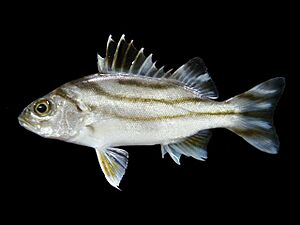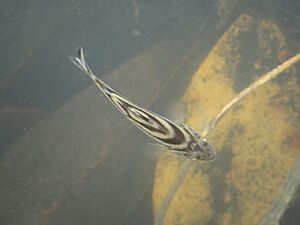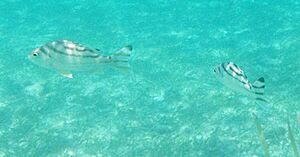Jarbua terapon facts for kids
Quick facts for kids Jarbua terapon |
|
|---|---|
 |
|
| Conservation status | |
| Scientific classification | |
| Synonyms | |
|
The Terapon jarbua, also known as the jarbua terapon, crescent grunter, or tiger perch, is a type of ray-finned fish. It belongs to the grunter family, Terapontidae. This fish lives in the warm waters of the Indo-Pacific region.
It's an important fish for people who catch them for food. Sometimes, you can also find it in aquariums. People who keep fish often call it a "target fish" because of the cool pattern you can see on its back from above.

Contents
What Does the Jarbua Terapon Look Like?
The Terapon jarbua is a medium-sized grunter. It has a body that's a bit flattened from side to side. Its mouth is slanted, and both jaws are about the same length. Young fish have teeth on the roof of their mouth, but many adults lose them.
This fish has two main fins on its back. The front part has 11 or 12 sharp spines, and the back part has 9 to 11 soft rays. The spiny part is strongly curved. Its tail fin is slightly forked.
The Terapon jarbua has a silvery-white body. It has 3 or 4 curved stripes that run from its neck area towards its tail. The lowest stripe goes right through the middle of its tail fin. There's also a black spot on the spiny part of its back fin. The tips of its tail lobes are black.
These fish usually grow to about 25 centimeters (10 inches) long. The longest one ever recorded was about 36 centimeters (14 inches). They become ready to reproduce when they reach about 13 centimeters (5 inches) in length.
Where Do Jarbua Terapons Live?
The Terapon jarbua lives across a very wide area. You can find it from the Red Sea and the coasts of eastern Africa, all the way down to South Africa. Its range extends through the Indian Ocean, including the Persian Gulf, and into the Pacific Ocean as far east as Samoa. It also lives northwards to Japan and south to the Arafura Sea.
In 2010, one of these fish was even seen in the eastern Mediterranean Sea. It likely got there by swimming through the Suez Canal.
Habitat and Life Cycle
The Terapon jarbua is a very adaptable fish. It can live in many different types of water, from pure freshwater to very salty water. This means you can find it in the ocean, along coastlines, in estuaries (where rivers meet the sea), coastal lagoons, and even far up rivers where the water is fresh.
Young T. jarbua fish are often found in sandy areas between tides, like in tidal pools. These fish are predators, meaning they hunt other animals for food. They mostly eat smaller fish.
Interestingly, they also act like "cleaner fish." They eat tiny parasites off larger fish. They are even known to eat scales from other fish, which are full of energy! The unique colors and small scales of the T. jarbua might help them avoid being attacked by other fish of their own kind. They also eat insects and other small creatures without backbones.
Young T. jarbua fish, when they are about 2 to 5 centimeters long, like to stay in groups. But as they grow bigger, between 9 and 15 centimeters, they become more territorial. This means they like to have their own space. They have even been seen digging small craters in the sand, which might help them stay put when the tide goes in and out.
These fish can make sounds using special muscles connected to their swimbladder. They use these sounds to communicate with each other. The sounds they make can change as they grow up and as their surroundings change. Even though young and adult fish can live in freshwater, they always go to the ocean to reproduce and lay their eggs.
Fishing and Aquariums
People catch Terapon jarbua using different types of fishing gear. This includes nets, traps, handlines, and bottom trawls. The fish are often sold fresh, or sometimes they are dried and salted.
You can also find this species in the aquarium trade, but it's not super common.
Naming the Jarbua Terapon
The Terapon jarbua was first officially described a long time ago in 1775. The name Djarbua came from an Arabic name. The description was put together by a Danish scientist named Johan Christian Fabricius. The first fish studied came from a place called Jeddah.
Later, in 1816, another scientist named Georges Cuvier created the group (or genus) called Terapon. Some scientists believe that the Terapon jarbua might actually be more than one species because it lives in such a wide area. For example, the fish found in the western Indian Ocean might be a different species from the one found in Japan.



